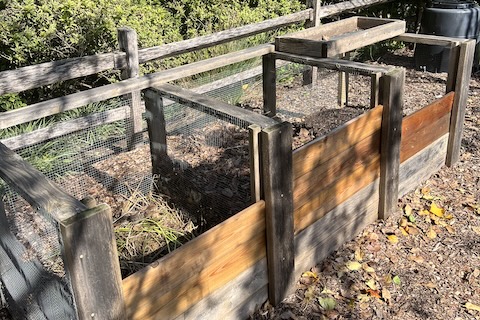AMES, Iowa – Gardeners are encouraged to compost leaves this fall to improve soil health. With plenty of leaves, grass clippings and garden debris available, residents can create compost piles that benefit the environment, recycle yard waste and nourish their gardens.
“Composting is a natural process that turns organic material into a dark, crumbly, earthy-smelling material called humus,” said Aaron Steil, consumer horticulture specialist with ISU Extension and Outreach. “It is an excellent soil amendment that improves soil structure, increases water-holding capacity and provides nutrients.”
Building and maintaining a compost pile
Effective composting requires a balance of carbon-rich “browns” (such as dried leaves and straw) and nitrogen-rich “greens” (like vegetable scraps and fresh grass clippings). The ideal carbon-to-nitrogen ratio is about 30:1. Steil recommends piles be at least three feet tall and wide to retain heat and should be turned regularly to maintain airflow and moisture.
“A three-bin system can work well with one bin used to stockpile materials until there is enough material to begin a composting batch,” said Steil. “The second bin is used for active composting and the third is used for the finished material to be stored until it can be used.”
Decomposition will still occur when the ratio of carbon to nitrogen is not perfect, but at a slower rate. “Compost created from fall materials, like fallen leaves and dead plant debris, is high in carbon and low in nitrogen. This means that special attention needs to be given to provide more of those green materials to create compost efficiently,” Steil noted. To accelerate the decomposition rate, gardeners can shred materials to increase the surface area for microorganisms to feed upon. Adding a small amount of nitrogen-rich fertilizer can also help. Regularly turning the compost helps introduces oxygen, keeping microbes healthy and growing. If the pile is dry, Steil advises adding water until it feels like a “wrung-out sponge.”
Steil recommends avoiding the use of meat, dairy products, pet waste, weed seeds and diseased plants in compost to prevent pests, pathogens and weeds. While heat is generated during the composting process, temperatures need to reach 150 to 170 degrees Fahrenheit to kill most pathogens and weed seeds, and most home compost piles do not reach this high a temperature.
“If a gardener does a great job of balancing the right ratio of browns and greens and provides the right amount of moisture while turning frequently, the pile will be warmer,” Steil said. “But even with the best of conditions, the pile may not be hot enough for long enough, so it’s best to avoid seeds and diseased plants.”
Using finished compost
After several months, compost should resemble rich, dark soil with an earthy aroma. This finished product can be used to top-dress lawns, mulch around trees or improve garden beds for spring planting. While compost can introduce some fertility to soil, its real benefit is introducing organic matter. Compost’s ability to improve soil structure and water-holding capacity improves aeration, supports the beneficial soil microbe population and helps the soil better hold and release essential plant nutrients. “This is why we sometimes call compost black gold!” Steil mentioned.
For related content and more information, visit:
Iowa State University Extension and Outreach builds a strong Iowa by engaging all Iowans in research, education, and extension experiences to address current and emerging real-life challenges.
Iowa State University Extension and Outreach will advance land-grant values by engaging all Iowans in solving today’s problems and preparing for a thriving future.
–ISU Extension


Comments are closed.